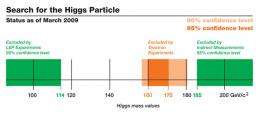New experiments constrain Higgs mass (w/Videos)

(PhysOrg.com) -- The territory where the Higgs boson may be found continues to shrink. The latest analysis of data from the CDF and DZero collider experiments at the U.S. Department of Energy's Fermilab now excludes a significant fraction of the allowed Higgs mass range established by earlier measurements. Those experiments predict that the Higgs particle should have a mass between 114 and 185 GeV/c2. Now the CDF and DZero results carve out a section in the middle of this range and establish that it cannot have a mass in between 160 and 170 GeV/c2.
"The outstanding performance of the Tevatron and CDF and DZero together have produced this important result," said Dennis Kovar, Associate Director of the Office of Science for High Energy Physics at the U.S. Department of Energy. "We're looking forward to further Tevatron constraints on the Higgs mass."
The Higgs particle is a keystone in the theoretical framework known as the Standard Model of particles and their interactions. According to the Standard Model, the Higgs boson explains why some elementary particles have mass and others do not.
So far, the Higgs particle has eluded direct detection. Searches at the Large Electron Positron collider at the European laboratory CERN established that the Higgs boson must weigh more than 114 GeV/c2. Calculations of quantum effects involving the Higgs boson require its mass to be less than 185 GeV/c2.
So far, CDF and DZero each have analyzed about three inverse femtobarns of collision data--the scientific unit that scientists use to count the number of collisions. Each experiment expects to receive a total of about 10 inverse femtobarns by the end of 2010, thanks to the superb performance of the Tevatron. The collider continues to set numerous performance records, increasing the number of proton-antiproton collisions it produces.
Provided by Fermi National Accelerator Laboratory



















